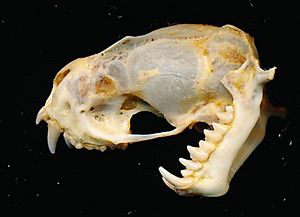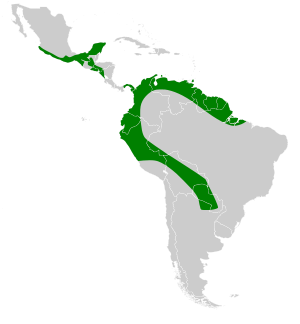Big crested mastiff bat facts for kids
Quick facts for kids Big crested mastiff bat |
|
|---|---|
 |
|
| Conservation status | |
| Scientific classification | |
| Genus: |
Promops
|
| Species: |
centralis
|
 |
|
The big crested mastiff bat (scientific name: Promops centralis) is a fascinating type of bat that lives in parts of Central America and South America. These bats are known for their unique features and how they live.
Contents
About the Big Crested Mastiff Bat
This bat was first officially described as a new species in 1915. A British animal expert named Oldfield Thomas gave it its scientific name. The very first bat of this kind that scientists studied was found by George F. Gaumer.
What Does It Look Like?
The big crested mastiff bat looks a lot like another bat called the brown mastiff bat. However, you can tell them apart by measuring their forearms (the part of their wing that's like our forearm). The big crested mastiff bat has a longer forearm, usually more than 51.5 millimeters (about 2 inches) long. The brown mastiff bat's forearm is shorter than 50 millimeters.
These bats have a special set of teeth, just like we do! They have 30 teeth in total, which helps them eat their food.
Life and Habits
Big crested mastiff bats are quite social animals. They don't like to be alone! During the day, they rest together in small groups, called colonies, with up to 6 other bats.
Where Do They Sleep?
They find cozy spots to sleep during the day. These can be:
- The space under loose tree bark
- The undersides of large palm leaves
- Inside tree hollows
How They Communicate
Like many bats, they use special sounds to find their way around and hunt for food. These sounds are called "search calls." Their calls are very quick, lasting only about 20 milliseconds. They start at a frequency of 23.0 kilohertz (kHz) and end at 25.6 kHz, with the loudest part of the sound at 24.7 kHz. These high-pitched sounds bounce off objects, helping the bats "see" in the dark.
Where They Live
The big crested mastiff bat can be found across many countries in Central America and South America.
Countries They Call Home
You can find these bats in:
- Argentina
- Belize
- Bolivia
- Brazil
- Colombia
- Ecuador
- El Salvador
- French Guiana
- Guatemala
- Guyana
- Honduras
- Mexico
- Nicaragua
- Paraguay
- Peru
- Suriname
- Trinidad and Tobago
- Venezuela
They can live in many different places, from areas right next to the sea all the way up to mountains as high as 1,800 meters (about 5,900 feet).
Images for kids
See also
 In Spanish: Murciélago mastín con cresta para niños
In Spanish: Murciélago mastín con cresta para niños



